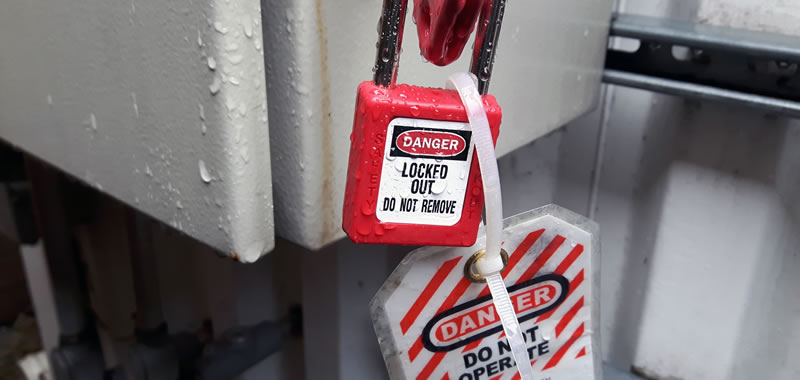
Editor's note: An earlier version of this post was published in May of 2018. We've updated the post with additional information and resources.
When ordering labels for outdoor use, it’s critical to make the right choices in the early steps of the process.
Go in the wrong direction, and you can wind up with a label that fades, peels, or cracks over time — which can potentially impact your product’s performance, create a negative brand impression, ding your reputation, and even cause safety issues for your customers.
On the other hand, making the right decisions can extend your label’s lifespan and dramatically improve your label’s performance.
So how will your supplier make the right choices for your outdoor labels? It all starts with understanding a few basic factors.
What’s the Environment?
The biggest factor to consider with outdoor labels is the environmental conditions the labels will be exposed to over time. The main culprits are sunlight, ice, rain, and heat.
![]() Sunlight can cause a process called “photodegradation.” If you’ve ever seen a badly faded road sign, you’ve seen photodegradation at work. The sun’s rays — primarily those in the ultraviolet end of the spectrum — can break down the chemical bonds that give pigments and dyes their color.
Sunlight can cause a process called “photodegradation.” If you’ve ever seen a badly faded road sign, you’ve seen photodegradation at work. The sun’s rays — primarily those in the ultraviolet end of the spectrum — can break down the chemical bonds that give pigments and dyes their color.
![]() Ice is a multifaceted threat. Not only is ice wet when it melts (see more about rain and water below) but when objects freeze and thaw, they tend to contract and expand. This movement can warp and rip labels and weaken adhesive bonds.
Ice is a multifaceted threat. Not only is ice wet when it melts (see more about rain and water below) but when objects freeze and thaw, they tend to contract and expand. This movement can warp and rip labels and weaken adhesive bonds.
![]() Rain can be one of the most destructive forces in nature. Water not only formed the Grand Canyon, it can:
Rain can be one of the most destructive forces in nature. Water not only formed the Grand Canyon, it can:
- Rip untreated paper labels to shreds
- Cause ink to smear, smudge, and drip
- Loosen the grip of adhesives, causing labels to peel
Heat can prevent adhesives from establishing a tight grip. And extreme heat, like extreme cold, can warp surfaces and strain any label affixed to them. This can happen to any material, including metal, glass, plastic, and wood.
For outdoor labels, these environmental hazards are nearly unavoidable.
For example, are you putting the label on playground equipment that will be exposed to the burning sun all year long? How about a snowplow that will be exposed to extreme cold and wet conditions with potential impacts and abrasion for hours at a time during the winter, but may sit in a hot garage — or direct sunlight — all summer? Or will the label be applied on the inside of a control panel for outdoor service equipment, where it might be exposed to very little light but wide variations in temperature?
Your supplier needs to choose label inks and materials that are well-suited to surviving whatever that environment may be. So, they should have several questions for you about precisely what your label will need to withstand, helping them make recommendations and discuss the options suited to your situation.
Your label printer’s first question will likely be, “What is the purpose of your outdoor label?”
What’s the Purpose?
Every label — indoors or outdoors — has a job to do. Some jobs are more crucial than others. But no matter what, if your label becomes damaged, peels off, or loses its legibility, it may fail to fulfill its function. This can lead to problems for your brand and can even imperil your customers and employees.
One frequent use of outdoor equipment labels is to serve as a warning. Outdoor equipment — ranging from construction machinery to sporting goods — can inflict pain, injury, and death when misused. Outdoor warning labels show users and bystanders how to avoid electrical shocks, dangerous projectiles, falls, and other safety risks.
Warning labels are typically required by state and federal law. When warning labels fail, outdoor equipment brands can face stiff legal penalties.
Another use for outdoor labels is to provide instructions. A label attached to a gas grill, for example, might tell users how to regulate the flame. This is an important lesson not just for safety but for the full enjoyment of the product.
Branding is another essential use for outdoor labels. If the label peels off a craft beer bottle inside a damp cooler, it may not hurt anyone, but it can damage your brand’s standing in the eyes of consumers. To most people, durability is a sign of quality.
To help your outdoor product label achieve its purpose, you need to work with your label supplier to make the right choices concerning three basic label elements: ink, material, and adhesive.
Choosing the Right Ink
As we described above, UV light from the sun’s rays can do a number on most inks – particularly bright colors like yellows, oranges, and reds, which tend to fade more quickly.
Naturally, if these colors are important for your label, then it’s important to take that into consideration from the start. For instance, if your label must warn users about a risk, you’re probably using a vivid red. If the wrong ink is selected and that red fades in a few months, your label can’t do its job – with potentially disastrous consequences.
The type of ink used on a label can dramatically impact how well the color holds up in sunlight. Today there is a wide range of choices to fit different budgets and needs. For example, many fade-resistant inks are available that are specifically formulated to endure sunlight exposure for much longer than standard inks. UV-blocking protective laminates also improve the staying power of the label.
Keep in mind, though, that all inks will fade to varying degrees when exposed to direct sunlight over time. When possible, placing the label in a location that is sheltered from direct UV light will greatly extend its lifespan.
Another way to add years to your label’s life is to use heavier coats of color. The more ink, the longer it will take to fade.
Choosing the Right Material
The materials from which your label is created will also impact its performance.
Paper, while a great choice for many, is perhaps the worst choice for damp environments. As we noted above, water can reduce paper to a pulp in a matter of moments. When paper gets wet, the hydrogen bonds that hold the wood fibers together dissolve.

Waterproof label materials are gaining popularity because brands want labels that look good and perform well, even in harsh settings. Synthetic materials such as polyethylene and polypropylene repel water. They are also more durable than paper, making them good options when you expect moisture.
Vinyl may be the most waterproof of all common label materials. (It’s no coincidence that they make raincoats out of vinyl.)
While some polyesters and polypropylenes perform well outdoors, in most cases, vinyl-based materials will have the longest lifespan and will be the most flexible.
Why is flexibility important, though? As we stated above, many surfaces and structures will expand and contract due to fluctuations in temperature and moisture. To accommodate this movement, the label will also need to expand and then contract back to its original shape.
This is where vinyl stands out as an excellent choice for outdoor labels. Vinyl is “multidimensionally stable,” which means it can expand and contract in multiple directions without cracking or peeling under the strain.
So, vinyl’s flexibility translates to durability for your labels.
Choosing the Right Adhesive
Adhesive may be the most mysterious element of label construction to non-experts.
You may be surprised to learn that different adhesive types take on different properties when used with varying label materials and application surfaces.
For example, an adhesive that works well on porous cardboard surfaces may fail entirely when applied to smooth, non-porous glass or metal — and vice versa.
Add environmental factors into the mix, and the adhesive equation gets quite complicated. Moisture, heat, cold, and caustic chemicals can all reduce adhesive strength, potentially leaving a gooey mess where a label was meant to be.
An experienced label printer will use their knowledge of how various adhesives interact with the environment, label materials, and application surfaces to help you choose an adhesive that won’t let you down when the rain starts pouring … or the sun starts shining.
Your Outdoor Label’s Best Defense: The Right Label Printer
Ultimately, the key point to remember when ordering a label for outdoor use is that you have options.
But to accurately weigh those options and make the right selections, your label supplier first needs a solid understanding of the environment in which your label must survive.
This is where your choice of label supplier can make a difference. An experienced and professional supplier will ask the right questions to help clarify exactly what you need, so they can point you in the right direction for success.

